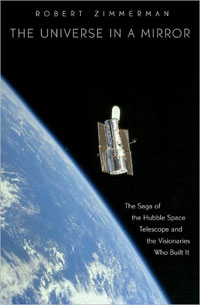Review: The Universe in a Mirrorby Jeff Foust
|
| For whatever reasons, Hubble, and the stunning images from it regularly released by NASA, has captured the hearts of the public, even if they do not grasp the astronomical significance of its observations. |
Zimmerman, a space historian whose previous books were about space stations (Leaving Earth) and Apollo 8 (Genesis), reaches back to the prehistory of Hubble, when astronomer Lyman Spitzer, winding down work on sonar research at the end of World War 2, wrote a paper for a classified RAND Project study on the utility of artificial satellites for astronomy research. While Spitzer was not the first to propose putting telescopes in space, Zimmerman notes, he was the first to make a realistic proposal based on existing technology. While that idea went nowhere, it did plant the seed for the concept of an orbiting space telescope that Spitzer and others nurtured. By the mid-1960s it had grown into what was called the Large Space Telescope (an alternative moniker, the Great Orbiting Device, was rejected by astronomers because of its acronym), a three-meter telescope that later became something that could be launched and serviced by NASA’s next-generation launcher, the space shuttle.
Getting from design to launch, though, was no easy task, as the book examines, as the LST (renamed after astronomer Edwin Hubble in 1983) faced difficulties in Congress in the 1970s to win funding, as well as a variety of technical and project management challenges. Then, of course, was the infamous problem with its optics discovered shortly after Hubble’s belated 1990 launch, and the successful effort to compensate for it with corrective optics, all of which are discussed in detail in the book from the points of view of the astronomers and others who worked on the mission.
The Universe in a Mirror covers much the same ground as some previous books, most notably Robert Smith’s The Space Telescope and Eric Chaisson’s insider account, The Hubble Wars; Smith’s book in particular goes into great detail about the gestation of Hubble. Those books, though, were published in the early 1990s, so Zimmerman is able to provide additional historical perspective, including the scientific results that Hubble has provided since that late 1993 servicing mission to correct its optics. He also includes a chapter on NASA’s announcement in early 2004 that the final shuttle servicing mission to Hubble would be cancelled because of post-Columbia safety (and financial) reasons, and the resulting backlash that lasted until current NASA administrator Mike Griffin reinstated the servicing mission. Zimmerman does appear to go too far when he tries to link the December 2004 resignation of Griffin’s predecessor, Sean O’Keefe, with a report critical of his decisions to cancel the shuttle mission and study a robotic repair option, released five days before O’Keefe’s announcement. While the strong opposition to his Hubble-related decisions may have contributed to his decision to leave the agency, the cause-and-effect suggested by Zimmerman isn’t necessarily the case, since O’Keefe had been rumored to be looking for bigger positions inside or outside of the federal government—he left NASA to become chancellor of LSU—for some months prior to the Hubble report.
Overall, The Universe in a Mirror provides an up-to-date history of the Hubble Space Telescope and its future, which astronomers hope includes several more years of operations after the shuttle servicing mission scheduled for launch in October. Zimmerman rightly notes that Hubble’s legacy goes far beyond the images it has taken and the scientific discoveries made by astronomers using the telescope. Hubble, he argues, did more than any other mission to demonstrate the utility of combining human and robotic operations in space, rather that pitting them against each other. “Human spaceflight in turn is expensive and difficult, but the addition of human skills to any robot operation makes the robots far more effective and useful,” he writes. “More importantly, humans can fix things, something no unmanned probe can do.”
| Hubble, Zimmerman argues, did more than any other mission to demonstrate the utility of combining human and robotic operations in space, rather that pitting them against each other. |
One thing The Universe in a Mirror does not explain, unfortunately, is just why the general public is so enamored with Hubble, to the point of writing members of Congress and signing petitions when its future was threatened in 2004, when they care far less about other spacecraft—or other, arguably more capable, groundbased telescopes, for that matter. It seems unlikely that the public fully appreciates the scientific breakthroughs Hubble has made, many of which are esoteric to general audiences. Is the public’s interest in Hubble limited to the pretty pictures released by NASA, or is there a deeper connection? And will that relationship continue to Hubble’s successor, the James Webb Space Telescope, or other space telescopes in the years to come? That, it seems, is a topic for a whole other book.
